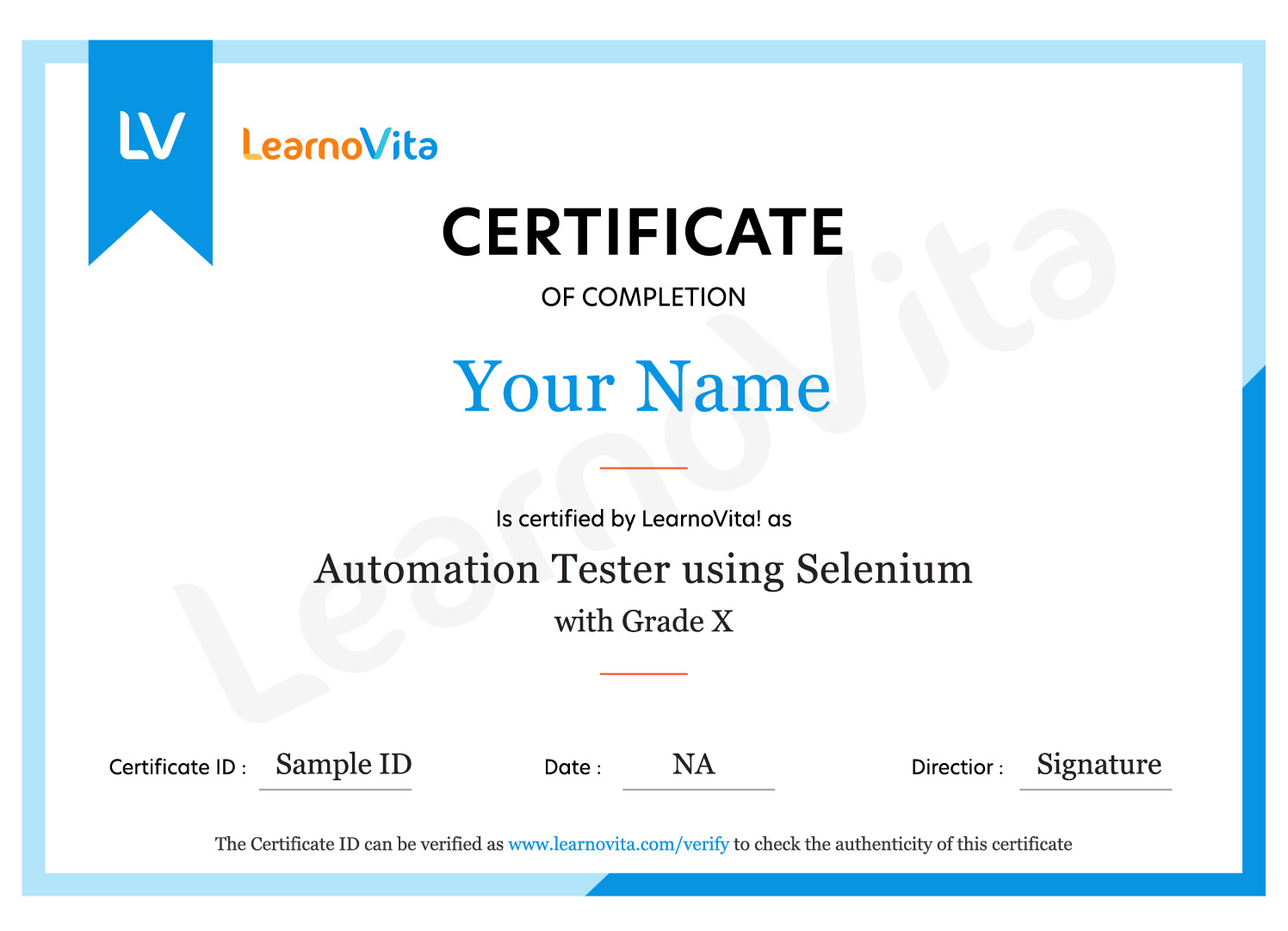Online Classroom Batches Preferred
29- Apr- 2024
Monday (Monday - Friday)
Weekdays Regular
08:00 AM (IST)
(Class 1Hr - 1:30Hrs) / Per Session
24- Apr- 2024
Wednesday (Monday - Friday)
Weekdays Regular
08:00 AM (IST)
(Class 1Hr - 1:30Hrs) / Per Session
27- Apr- 2024
Saturday (Saturday - Sunday)
Weekend Regular
11:00 AM (IST)
(Class 3hr - 3:30Hrs) / Per Session
27- Apr- 2024
Saturday (Saturday - Sunday)
Weekend Fasttrack
11:00 AM (IST)
(Class 4:30Hr - 5:00Hrs) / Per Session
Can't find a batch you were looking for?
₹21000
₹16000
10% OFF Expires in
No Interest Financing start at ₹ 5000 / month
Top Skills You Will Gain
- C# Programming
- ASP.NET Web Development
- .NET Framework
- MVC Design Pattern
- Database Integration
- Web API Development
- Frontend Technologies
- Testing and Debugging
Dot NET Course Key Features 100% Money Back Guarantee
-

5 Weeks Training
For Become a Expert -

Certificate of Training
From Industry Dot NET Experts -

Beginner Friendly
No Prior Knowledge Required -

Build 3+ Projects
For Hands-on Practices -

Lifetime Access
To Self-placed Learning -

Placement Assistance
To Build Your Career
Top Companies Placement
- Designation
-
Annual SalaryHiring Companies
DotNet Course Curriculum
Trainers Profile
Our DotNet instructors are certified experts with extensive industry experience who leading multinational corporations currently employ. They are dedicated to equipping learners with cutting-edge insights and industry best practices in DotNet, ensuring their readiness for success in the competitive job landscape.
Syllabus of DotNet Certification Online Course Download syllabus
- Solutions Overview
- Cybersecurity Challenges
- Role of DotNet Networks in Modern Security Infrastructure
- Firewall Platform Overview
- Components of Security Infrastructure
- Functionality and Role of Each Component
- Policy Configuration and Rule Management
- Application of Security Profiles
- Configuration Best Practices
- Implementation Strategies for Robust Security
- Techniques for Effective Threat Mitigation
- Preparing Against Various Cyberattack Scenarios
- Leveraging Threat Prevention Features Effectively
- Real-time Detection Techniques
- Strategies for Mitigating Detected Threats
- Understanding the Functionality and Importance of IPS
- Policy Configuration for IPS
- Threat Detection and Prevention Mechanisms
- Implementing and Managing URL Filtering Policies
- Enforcing Web Access Controls
- Ensuring Secure Content Handling
- Configuring VPN Tunnels
- Remote Access Configuration Best Practices
- Site-to-Site Connectivity Management Techniques
- Fine-tuning Security Policies for Optimal Performance
- Strategies for Performance Optimization
- Regular Review and Adjustment of Security Policies
- Analyzing Log Data for Security Insights
- Generating Comprehensive Security Reports
- Planning Incident Response Based on Log Analysis
- Advanced Threat Protection Mechanisms and Tools
- Leveraging Threat Intelligence for Proactive Defense
- Implementing Strategies for Proactive Threat Mitigation
(15)
view More
view Less
Need customized curriculum?
Contact Us
+91 9176954999
(24/7 Support)
Request for Information
Industry Projects
Mock Interviews
- Mock interviews by Learnovita give you the platform to prepare, practice and experience the real-life job interview. Familiarizing yourself with the interview environment beforehand in a relaxed and stress-free environment gives you an edge over your peers.
- Our mock interviews will be conducted by industry experts with an average experience of 7+ years. So you’re sure to improve your chances of getting hired!
How Learnovita Mock Interview Works?
DotNet Training Objectives
Acquiring skills in Dot NET opens doors to developing versatile applications across diverse platforms such as web, desktop, and mobile. With robust support from Microsoft and a wide array of functionalities, Dot NET is invaluable for various software development projects.
While prerequisites may vary, having a basic grasp of programming concepts and familiarity with object-oriented languages like C# can greatly aid in learning Dot NET effectively.
Common tools in Dot NET development include
- Visual Studio IDE
- Visual Studio Code
- .NET SDK
- NuGet Package Manager
- Entity Framework Core
- Azure DevOps
Dot NET skills are highly sought after due to their extensive use in enterprise-level applications across industries. Mastery of Dot NET significantly enhances job opportunities for software developers and engineers.
The future of Dot NET is promising, with continuous updates and advancements, including support for cross-platform development and cloud-native applications. Dot NET remains relevant, adapting to evolving technology landscapes.
A Dot NET course generally covers areas like
- ASP.NET for web development
- Entity Framework for data access
- MVC architecture, web services
- deployment strategies
Yes, pursuing Dot NET can be a lucrative career choice in India, given the high demand for skilled Dot NET professionals across sectors like IT, finance, healthcare, and e-commerce.
- Absolutely, our Dot NET training programs integrate real-world projects.
- These projects offer practical application of learned skills.
- Engaging in real projects enhances hands-on experience and prepares students for professional demands.
- Information Technology (IT) sector
- Finance and Banking
- Healthcare industry
- E-commerce and Retail
- Manufacturing sector
- Video tutorials covering diverse Dot NET concepts and methodologies
- Comprehensive documentation and guides for quick reference
- Hands-on labs and practice exercises to reinforce understanding
- Access to specialized tools and software necessary for Dot NET development
view More
view Less
DotNet Exam & Certification
- Microsoft Certified: .NET Developer Associate
- Microsoft Certified: Azure Developer Associate (with emphasis on .NET development)
- Microsoft Certified: Azure Solutions Architect Expert (with .NET integration)
- Microsoft Certified: DevOps Engineer Expert (with .NET focus)
- Microsoft Certified: Security, Compliance, and Identity Fundamentals (relevant for .NET security)
- Certifies proficiency and competencies in Dot NET development
- Amplifies credibility and marketability within the job arena
- Unlocks avenues for career progression and potential salary increments
- Reflects dedication to continuous learning and professional evolution
Yes, obtaining a .NET certification significantly increases your chances of securing employment in the software development field.
A fundamental grasp of programming principles and languages like C#. Familiarity with the Dot NET framework and development tools. Engaging in hands-on Dot NET development projects is advantageous. Requirements may vary per certification, necessitating a thorough review of individual prerequisites.
- Enroll in our Dot NET certification training
- Practice coding exercises and scenarios aligned with exam topics
- Leverage resources such as practice exams, forums, and community groups for supplementary support
- Seek participation in study groups or guidance from mentors who have achieved the certification

Recently placed students
My sincere appreciation & gratitude to the Training & Placement Department and all staff of LearnoVita for their efforts in imparting quality technical and aptitude training. I am very grateful to them for effectively and sincerely helping me to grab the first-ever opportunity that came into my life.
Pranav Srinivas
Software Testing, CapgeminiDotNet Course FAQ's
Certainly, you are welcome to join the demo session. However, due to our commitment to maintaining high-quality standards, we limit the number of participants in live sessions. Therefore, participation in a live class without enrollment is not feasible. If you're unable to attend, you can review our pre-recorded session featuring the same trainer. This will provide you with a comprehensive understanding of our class structure, instructor quality, and level of interaction.
All of our instructors are employed professionals in the industry who work for prestigious companies and have a minimum of 9 to 12 years of significant IT field experience. A great learning experience is provided by all of these knowledgeable people at LearnoVita.
- LearnoVita is dedicated to assisting job seekers in seeking, connecting, and achieving success, while also ensuring employers are delighted with the ideal candidates.
- Upon successful completion of a career course with LearnoVita, you may qualify for job placement assistance. We offer 100% placement assistance and maintain strong relationships with over 650 top MNCs.
- Our Placement Cell aids students in securing interviews with major companies such as Oracle, HP, Wipro, Accenture, Google, IBM, Tech Mahindra, Amazon, CTS, TCS, HCL, Infosys, MindTree, and MPhasis, among others.
- LearnoVita has a legendary reputation for placing students, as evidenced by our Placed Students' List on our website. Last year alone, over 5400 students were placed in India and globally.
- We conduct development sessions, including mock interviews and presentation skills training, to prepare students for challenging interview situations with confidence. With an 85% placement record, our Placement Cell continues to support you until you secure a position with a better MNC.
- Please visit your student's portal for free access to job openings, study materials, videos, recorded sections, and top MNC interview questions.
LearnoVita Certification is awarded upon course completion and is recognized by all of the world's leading global corporations. The National Institute of Education (NIE) in Singapore and LearnoVita are the exclusive authorized Oracle, Microsoft, Pearson Vue, and PSI exam centers, as well as an authorized partner of AWS. Additionally, those who want to pass the National Authorized Certificate in a specialized IT domain can get assistance from LearnoVita's technical experts.
As part of the training program, LearnoVita provides you with the most recent, pertinent, and valuable real-world projects. Every program includes several projects that rigorously assess your knowledge, abilities, and real-world experience to ensure you are fully prepared for the workforce. Your abilities will be equivalent to six months of demanding industry experience once the tasks are completed.
At LearnoVita, participants can choose from instructor-led online training, self-paced training, classroom sessions, one-to-one training, fast-track programs, customized training, and online training options. Each mode is designed to provide flexibility and convenience to learners, allowing them to select the format that best suits their needs. With a range of training options available, participants can select the mode that aligns with their learning style, schedule, and career goals to excel in DotNet.
LearnoVita guarantees that you won't miss any topics or modules. You have three options to catch up: we'll reschedule classes to suit your schedule within the course duration, provide access to online class presentations and recordings, or allow you to attend the missed session in another live batch.
Please don't hesitate to reach out to us at contact@learnovita.com if you have any questions or need further clarification.
To enroll in the DotNet Course at LearnoVita, you can conveniently register through our website or visit any of our branches in India for direct assistance.
Yes, after you've enrolled, you will have lifetime access to the student portal's study materials, videos, and top MNC interview questions.
At LearnoVita, we prioritize individual attention for students, ensuring they can clarify doubts on complex topics and gain a richer understanding through interactions with instructors and peers. To facilitate this, we limit the size of each DotNet batch to 5 or 6 members.
The average annual salary for DotNet Professionals in India is 5 LPA to 8 LPA.
view More
view Less













